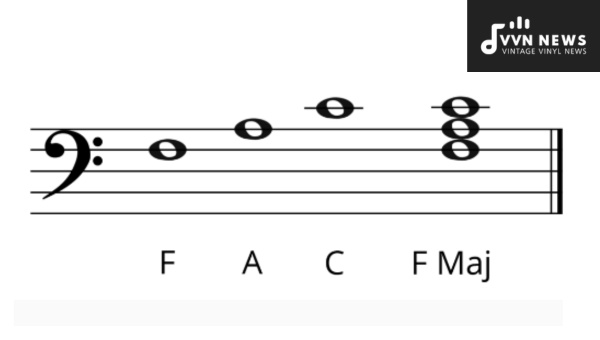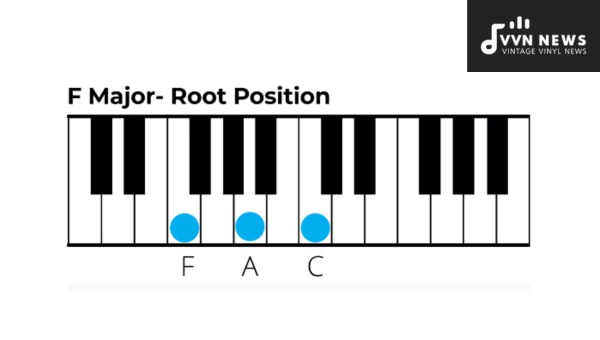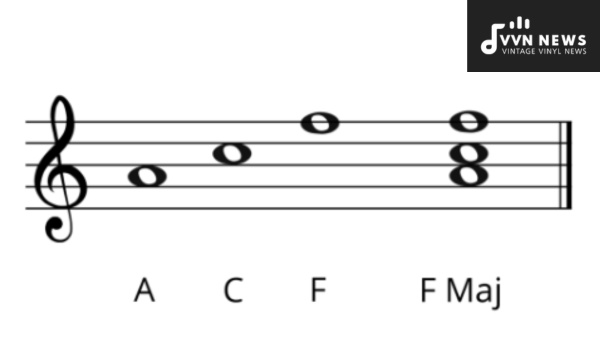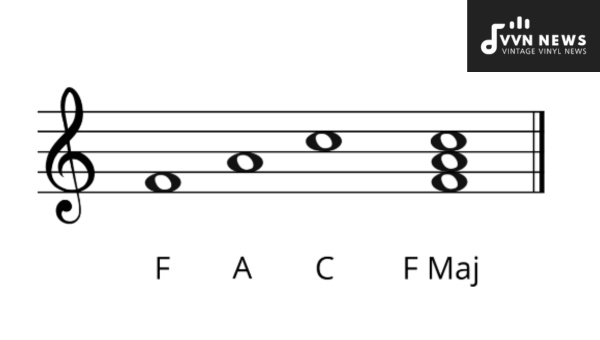Welcome to my blog post, A Guide to the F Major Triad in Theory. In this article, I will be taking you through the ins and outs of the F Major Triad and its theoretical aspects.
Whether you are a beginner musician or have some experience in music theory, understanding triads is essential for building a solid foundation in musical composition and understanding chord progressions.
When it comes to understanding music theory, particularly chords, and harmony, the F Major Triad plays a crucial role.
As musicians, we often come across this triad when exploring different keys and chord progressions.
With its unique combination of notes, the F Major Triad offers a distinct sound that can be found in countless songs across various genres.
We will delve into the theory behind the F Major Triad, exploring its composition, qualities, and applications. So grab your instrument or get ready to delve into some theory. It’s time to explore the F Major Triad.
What’s an F Major Triad?
A triad is a three-note chord consisting of a root note, a third interval, and a fifth interval. The F Major Triad specifically is formed from the F major scale, which includes the notes F, G, A, B♭, C, D, and E.
The F Major Triad consists of the root note F, followed by the major third interval A and the perfect fifth interval C.
In terms of music theory, this triad is significant as it forms the foundation for creating harmonies and chord progressions in the key of F major.
It has a bright and uplifting sound that can evoke various emotions in music compositions.
How do you form a F Major Triad?

Forming an F Major Triad involves understanding the composition and structure of the chord. Here’s a step-by-step guide on how to build an F Major Triad:
- Start with the F major scale: The F major scale consists of the notes F, G, A, B♭, C, D, and E.
- Identify the root note: The root note of the triad is F. This serves as our starting point.
- Determine the third interval: Count up four half steps from the root note (F) to find the major third interval. In this case, A is the major third interval.
- Find the fifth interval: Count up three-and-a-half steps from the major third interval (A) to find the perfect fifth interval. In this case, C is our perfect fifth.
- Combine all three notes: Once you’ve identified all three notes (F, A, and C), you have formed an F Major Triad.
By following these steps, you can form an F Major Triad on any instrument or in music notation software. This triad serves as a fundamental building block for creating harmonies and chord progressions in the key of F major.
Also Read: G Major Scales And Chords [Expand Your Musical Understandings]
Why is the F Major Triad significant in music theory?
The F Major Triad holds significance in music theory for several reasons. Understanding its role and qualities can greatly enhance your understanding and composition skills.
Here are a few key reasons why the F Major Triad is significant:
Key Signature
The F Major Triad is built from the F major scale, which consists of the notes F, G, A, B♭, C, D, and E.
As one of the most commonly used key signatures, the triads formed from this scale offer a solid foundation for creating harmonies in F major compositions.
Harmonic Function
In functional harmony, chords are categorized into different functions based on how they progress within a musical piece.
The F Major Triad falls under the category of tonic chords, which provide stability and a sense of resolution within a piece in the key of F major.
Chord Progressions
The triad’s structure allows it to be easily incorporated into chord progressions. It can be paired with other triads or extended chords to create beautiful chord progressions that evoke different emotions and moods within music compositions.
Familiar Sound
The F Major Triad has a distinct sound that is instantly recognizable to many listeners. Its bright and uplifting quality makes it suitable for various musical genres such as pop, classical, rock, and jazz.
Versatility
The versatility of the F Major Triad allows it to be used in different contexts within a composition. It can serve as the foundation for melodies or harmonies or be used as an accompanying chord during improvisation or soloing.
Understanding these aspects of the F Major Triad will not only enhance your theoretical knowledge but also allow you to apply this knowledge more effectively when composing or playing music. Now let’s move on to exploring the different inversions of the F Major Triad.
Also Read: D Major: The Scales And Chords [Broaden Your Musical Vocabulary]
What triads are in the F Major Triad?
In the key of F major, there are seven triads that can be formed. These triads are built from the seven different notes of the F major scale. Let’s take a closer look at each of these triads:
- F Major (F-A-C): The F Major Triad is built on the root note of F and consists of a major third interval (A) and a perfect fifth interval (C). This is the primary triad in the key of F major and provides a strong and stable foundation.
- G Minor (G-B♭-D): The G Minor Triad is built on the second note of the F major scale. It consists of a minor third interval (B♭) and a perfect fifth interval (D). This triad adds a melancholic and introspective element to compositions.
- A Minor (A-C-E): The A Minor Triad is built on the third note of the F major scale. It consists of a minor third interval (C) and a perfect fifth interval (E). Similar to G minor, this triad brings an emotional depth to music compositions.
- B♭ Major (B♭-D-F): The B♭ Major Triad is built on the fourth note of the F major scale. It consists of a major third interval (D) and a perfect fifth interval (F). This triad adds brightness and tension to musical progressions.
- C Major (C-E-G): The C Major Triad is built on the fifth note of the F major scale. It consists of a major third interval (E) and a perfect fifth interval (G). This is another fundamental triad that provides stability in compositions.
- D Minor (D-F-A): The D Minor Triad is built on the sixth note of the F major scale. It consists of a minor third interval (F) and a perfect fifth interval (A). This triad carries a sense of longing and sadness.
- E Diminished (E-G-B♭): The E Diminished Triad is built on the seventh note of the F major scale. It consists of two minor third intervals (G and B♭). This triad creates tension and instability, often leading to resolution.
These triads are derived from the F major scale and can be used interchangeably in compositions within the key of F major to create different moods and emotions.
How do you play the F Major Triad on instruments?

Playing the F Major Triad on various instruments requires an understanding of both the theory and technique. Let’s explore how to play the F Major Triad on some popular instruments:
Piano/Keyboard:
- Position your hand with your thumb (1st finger) on F, your middle finger (3rd finger) on A, and your little finger (5th finger) on C.
- Play all three notes simultaneously to create the F Major Triad.
- Experiment with different hand positions and inversions to explore different voicings and sounds.
Guitar:
- Place your index finger on the 1st fret of the low E string (6th string) to play an F note.
- Place your ring finger on the 3rd fret of the A string (5th string) to play an A note.
- Place your pinky finger on the 3rd fret of the D string (4th string) to play a C note.
- Strum all three strings together from the low E string upwards for a full-sounding F Major Triad.
Ukulele:
- Position your ring finger on the 2nd fret of the G string (3rd string).
- Position your middle finger on the 1st fret of the E string (4th string).
- Position your index finger on the 1st fret of the A string (2nd string).
Strum all three strings open or pluck them individually for a sweet-sounding F Major Triad.
Also Read: A Major Scale [The Key To Bright, Cheerful Musical Pieces]
Violin/Viola/Cello:
- Start by placing your first or second finger on the E location in the first position depending upon which instrument you are playing (violin, viola, or cello) to play an F note.
- Place your second finger on the A string to play an A note.
- Lastly, place your pinky finger on the D string to play a C note.
- Bow or pluck all three strings together to produce the F Major Triad.
These are just some examples of how to play the F Major Triad on different instruments.
What are the F Major Triad inversions?
Inversions are a way to reorganize the notes of a chord. They allow us to change the order of the notes while still maintaining the same chord quality.
When it comes to the F Major Triad, we can create three inversions: the root position, the first inversion, and the second inversion.
- Root Position: The root position is when the F note is in the bass or lowest note of the chord. It is denoted as “F” in chord notation.
- First Inversion: To create the first inversion of an F Major Triad, we take the third interval, A, and move it up an octave. In other words, A becomes the highest note of the triad. This inversion is denoted as “F/A” in chord notation.
- Second Inversion: For the second inversion, we take both F and A and move them up one octave. The fifth interval, C, becomes the lowest note or bass note of the triad. This inversion is denoted as “C/F” in chord notation.
Each inversion adds a unique flavor to your music composition and provides options for creating interesting progressions and voicings on different instruments.
Also Read: E Major: Scale And Chords [Exciting Sounds For Your Compositions]
How are F Major Triad 1st and 2nd inversions played on guitar and piano?

Playing the F Major Triad inversions on guitar and piano may seem daunting at first, but with a little practice and guidance, you’ll be able to master them in no time.
F Major Triad 1st Inversion:
On guitar, the first inversion of the F Major Triad can be played as follows:
- Start by placing your index finger on the first fret of the low E string (the thickest string). This is your F note, which is the root note of the inversion.
- Next, place your middle finger on the second fret of the D string (the fourth string). This is your A note, which is the major third interval of the triad.
- Finally, place your ring finger on the third fret of the G string (the third string). This is your C note, which is the perfect fifth interval.
Strum all six strings from the low E string down to create a full-sounding F Major Triad in its first inversion.
On piano, a simple way to play the first inversion is by placing your thumb on F, which is below middle C. Then, place your middle finger on A, and your pinky finger on C. Play these three notes simultaneously or individually to create the desired sound.
F Major Triad 2nd Inversion:
On guitar, playing the second inversion of the F Major Triad involves slightly different positioning:
- Begin by placing your index finger on the first fret of the B string (the second string from thin to thick). This is where you will find your C note, which becomes the bass or lowest note in this inversion.
- Position your middle finger on the second fret of the G string (the third string), which is your F note.
- Place your ring finger on the third fret of the D string (the fourth string), which is your A note.
Strumming all six strings or focusing on strings four to one will give you a rich and resonant sound when playing the F Major Triad in its second inversion.
On piano, to play the second inversion, start with C as your thumb on the keyboard below middle C. Place your index finger on F, and your pinky finger on A. As with the first inversion, you can play these notes simultaneously or individually for different effects.
Famous Pieces Utilizing the F Major Triad
The F Major Triad finds its way into many famous compositions across various genres. Let’s explore some noteworthy pieces where this triad plays a prominent role.
Classical Music:
- Beethoven – Symphony No. 6 “Pastoral”: In the first movement of this symphony, Beethoven prominently uses the F Major Triad to evoke a sense of tranquility and nature. Listen for the uplifting and serene quality of the triad throughout the piece.
Pop/Rock Music:
- The Beatles – Let It Be: The iconic chorus of “Let It Be” by The Beatles features an F Major Triad progression (F-C-G). This choice creates a sense of resolution and comfort, contributing to the song’s timeless appeal.
- Adele – Someone Like You: Adele’s emotional ballad heavily relies on the F Major Triad as its main chord progression (F-Dm-Am-B♭). These chords, when combined with Adele’s powerful vocals, create a poignant and heartfelt atmosphere.
Jazz Music:
- John Coltrane – Giant Steps: In John Coltrane’s iconic jazz composition “Giant Steps,” you’ll encounter instances where an F Major Triad is briefly inserted within complex harmonic progressions. These moments provide a tonal center and act as a melodic anchor amidst intricate jazz improvisations.
- Louis Armstrong – What a Wonderful World: This well-loved jazz standard incorporates an F Major Triad in several parts of its chord progression (F-Gm7-C7) to accentuate its optimistic and joyful message.
Film Scores:
- John Williams – Jurassic Park Theme: The uplifting melodies in John Williams’ theme for Jurassic Park utilize the F Major Triad to convey themes of wonder, adventure, and discovery. Listen for instances where the triad is used to highlight key moments in the music.
Whether you listen to classical, pop, rock, jazz, or film scores, understanding and recognizing the F Major Triad in these famous compositions will deepen your appreciation for the role it plays in creating beautiful and memorable music.
Also Read: C Sharp Major Pentatonic Scale [Crisp & Clear Tones For Your Music]
FAQs the F Major Triad
What is the formula to form an F Major Triad?
To form an F Major Triad, start with the root note F, then add the major third interval, which is four half steps above the root note, and finally add the perfect fifth interval, which is seven half steps above the root note.
Can I use the F Major Triad in other keys besides F Major?
Yes, you can use the F Major Triad in other keys by transposing it to different starting notes. Each key has its own set of triads, and by understanding the relationship between intervals and scales, you can apply the same logic to create triads in different keys.
How do I play an F Major Triad on guitar?
To play an F Major Triad on guitar, place your index finger on the first fret of the low E string for the root note (F), your middle finger on the second fret of the G string for the major third (A), and your ring finger on the third fret of the B string for the perfect fifth (C).
How do I play an F Major Triad on the piano?
To play an F Major Triad on piano, place your thumb on F, your middle finger on A (major third), and your pinky finger on C (perfect fifth). Play all three notes simultaneously or in succession to form a complete triadic sound.
Are there any famous songs that use the F Major Triad?
Yes! Some famous songs that use an F Major Triad include “Let It Be” by The Beatles, “Clocks” by Coldplay, and “Piano Man” by Billy Joel. The versatile nature of this triad allows it to be used in various musical genres across different time periods.
Conclusion
The F Major Triad is an essential chord in music theory and composition. It consists of the root note F, major third interval A, and perfect fifth interval C.
This triad forms the foundation of harmonies and chord progressions in the key of F major. Understanding its inversions and applications allows musicians to create interesting voices and progressions.
Whether you are a beginner or advanced musician, mastering the F Major Triad will expand your musical possibilities and enhance your compositions.








